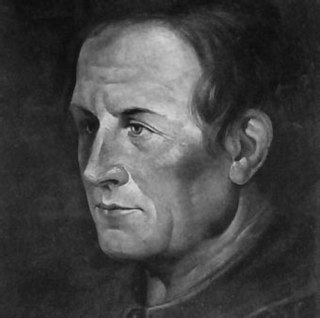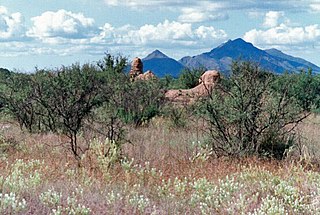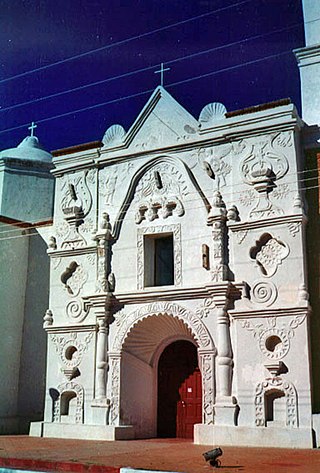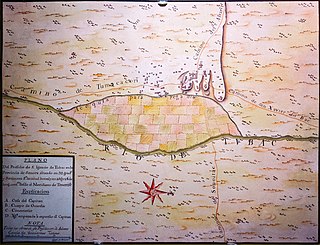Between the years of 1539 and 1821, the Spanish Empire explored, colonized, and ruled over what is the state of Arizona in the United States.
Between the years of 1539 and 1821, the Spanish Empire explored, colonized, and ruled over what is the state of Arizona in the United States.
In 1539, Fray Marcos de Niza passed through what is now southeastern Arizona in search of the Seven Cities of Cibola. In 1540, Francisco Vázquez de Coronado explored eastern Arizona also in search of the mythical cities.
In 1691, the Jesuit missionary, Father Eusebio Francisco Kino travelled through the Pimería Alta, establishing missions to convert the natives to Christianity. [1] Most of the missions founded by Kino were destroyed and/or abandoned because of native American attacks. Missions continued to be established in Arizona, but at a very slow pace. In 1768, the Spanish crown discontinued Jesuit missionary work in the Americas, and missionary work was continued under the Franciscans. [2]
In the 18th century, many native tribes were attacking Spanish settlements in Arizona. To counter this, the Spanish Army built several presidios in northern New Spain. In 1751, the native Pima people revolted against the Spanish in the Pima Revolt, and over 100 settlers were killed and most of the remaining settlers fled in fear, leaving several missions abandoned. [3] In 1752, Presidio San Ignacio de Tubac was built in what is now Tubac, Arizona. [4] In 1775, Presidio San Agustín del Tucsón was built in what is now Tucson, Arizona. [5] Multiple battles took place at Tucson between the Spanish and the Apache. In 1776, Presidio Santa Cruz de Terrenate was founded near what is now Tombstone, Arizona. [6] Eventually, the Spanish made peace with the Apache, by giving them beef, blankets, and guns in return of them living in the establacimientos de paz (peace camps). Apaches who made peace with the Spanish were referred to as Apaches de paz (Apaches of Peace).
In the late 18th century, the Spanish had made peace with the Apache, allowing the area to prosper. Mining began in the Arivaca area in search of silver and gold. The Spanish began giving large land grants in southeastern Arizona, which were turned into ranches (ranchos). In 1821, the Treaty of Córdoba was signed, ending the Mexican War of Independence and giving Mexico control over New Spain. [7]

Mission San Xavier del Bac is a historic Spanish Catholic mission located about 10 miles (16 km) south of downtown Tucson, Arizona, on the Tohono O'odham Nation San Xavier Indian Reservation. The mission was founded in 1692 by Padre Eusebio Kino in the center of a centuries-old settlement of the Sobaipuri O'odham, a branch of the Akimel or River O'odham located along the banks of the Santa Cruz River. The mission was named for Francis Xavier, a Christian missionary and co-founder of the Society of Jesus in Europe. The original church was built to the north of the present Franciscan church. This northern church or churches served the mission until it was razed during an Apache raid in 1770.

Tumacacori is an unincorporated community in Santa Cruz County, Arizona, United States, which abuts the community of Carmen. Together, the communities constitute the Tumacacori-Carmen census-designated place (CDP). The population of the CDP was 393 at the 2010 census.

The Pimería Alta was an area of the 18th century Sonora y Sinaloa Province in the Viceroyalty of New Spain, that encompassed parts of what are today southern Arizona in the United States and northern Sonora in Mexico.

Eusebio Francisco Kino, SJ, often referred to as Father Kino, was an Italian Jesuit, missionary, geographer, explorer, cartographer, mathematician and astronomer born in the Bishopric of Trent, Holy Roman Empire.

Tumacácori National Historical Park is located in the upper Santa Cruz River Valley in Santa Cruz County, southern Arizona. The park consists of 360 acres (1.5 km2) in three separate units. The park protects the ruins of three Spanish mission communities, two of which are National Historic Landmark sites. It also contains the landmark 1937 Tumacácori Museum building, also a National Historic Landmark.

The Spanish missions in the Sonoran Desert are a series of Jesuit Catholic religious outposts established by the Spanish Catholic Jesuits and other orders for religious conversions of the Pima and Tohono O'odham indigenous peoples residing in the Sonoran Desert. An added goal was giving Spain a colonial presence in their frontier territory of the Sonora y Sinaloa Province in the Viceroyalty of New Spain, and relocating by Indian Reductions settlements and encomiendas for agricultural, ranching, and mining labor.

Beginning in the 16th century Spain established missions throughout New Spain in order to facilitate colonization of these lands.

Mission San José de Tumacácori is a historic Spanish mission near Nogales, Arizona, preserved in its present form by Franciscans in 1828.

Tubac Presidio State Historic Park, located in Tubac, Arizona, US, preserves the ruins of the Presidio San Ignacio de Tubac and various other buildings, thereby presenting a timeline of European settlement in this Southern Arizona town. The park contains a museum, a number of historic sites, an underground archeology exhibit displaying the excavated foundations of the Tubac Presidio, and a picnic area. Various cultural events are held on-site throughout the year, including Anza Days (October), Los Tubaqueños living history presentations, archeological tours, and nature walks. Until recently, the park was administered by Arizona State Parks but is the first park in the Arizona state park system. As a result of budget cutbacks, the Tubac Presidio was scheduled to be closed in 2010, but was rescued by local residents and the Tubac Historical Society. It is now operated by The Friends of the Presidio and staffed with dedicated volunteers.

La Misión de San Gabriel de Guevavi was founded by Jesuit missionary priests Eusebio Kino and Juan María de Salvatierra in 1691. Subsequent missionaries called it San Rafael and San Miguel, resulting in the common historical name of Mission Los Santos Ángeles de Guevavi.

Mission San Cayetano de Calabazas, also known as Calabasas, is a Spanish Mission in the Sonoran Desert, located near present-day Tumacacori, Arizona, United States.

Mission San Pedro y San Pablo del Tubutama is a Spanish mission located in Tubutama, Sonora, first founded in 1691 by Eusebio Francisco Kino.
The Sobaipuri were one of many indigenous groups occupying Sonora and what is now Arizona at the time Europeans first entered the American Southwest. They were a Piman or O'odham group who occupied southern Arizona and northern Sonora in the 15th–19th centuries. They were a subgroup of the O'odham or Pima, surviving members of which include the residents of San Xavier del Bac which is now part of the Tohono O'odham Nation and the Akimel O'odham.

The Pima Revolt, also known as the O'odham Uprising or the Pima Outbreak, was a revolt of Pima native Americans in 1751 against colonial forces in Spanish Arizona and one of the major northern frontier conflicts in early New Spain.

The Presidio of San Ignacio de Túbac or Fort Tubac was a Spanish built fortress. The fortification was established by the Spanish Army in 1752 at the site of present-day Tubac, Arizona. Its ruins are preserved in the Tubac Presidio State Historic Park.

Presidio San Agustín del Tucsón was a presidio located within Tucson, Arizona, United States. The original fortress was built by Spanish soldiers during the 18th century and was the founding structure of what became the city of Tucson. After the American arrival in 1846, the original walls were dismantled, with the last section torn down in 1918. A reconstruction of the northeast corner of the fort was completed in 2007 following an archaeological excavation that located the fort's northeast tower.

Mission San Cosme y Damián de Tucsón, originally known as Mission San Agustín del Tucson, was a Spanish mission located in present-day Tucson, Pima County, Arizona. It was established in 1692 by Jesuit missionary Eusebio Francisco Kino as a visita, or "visiting chapel", of the nearby Mission San Xavier del Bac. Today, almost nothing remains of the original complex.
José Antonio Garrucho (1712–1785) was a Jesuit missionary to Mexico, who served at Mission Los Santos Ángeles de Guevavi and Mission San Miguel Arcángel de Oposura. He was implicated in the events leading up to the Pima Revolt of 1751.
Francisco Xavier Pauer was a Jesuit missionary to Mexico. He replaced Joseph Garrucho at Mission Los Santos Ángeles de Guevavi after the Pima Revolt of 1751, and worked in the area until the expulsion of the Jesuits in 1767.
Jabanimó or Hawani Mo'o was an Akimel O'odham leader involved in Native American uprisings during the 1750s, possibly including the 1751 Pima Revolt.
{{cite web}}: CS1 maint: numeric names: authors list (link)